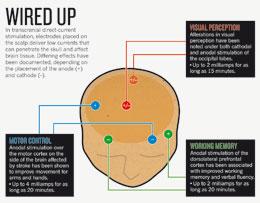Last year a succession of volunteers sat down in a research lab in Albuquerque, New Mexico to play DARWARS Ambush!, a video game designed to train US soldiers bound for Iraq. Each person surveyed virtual landscapes strewn with dilapidated buildings and abandoned cars for signs of trouble — a shadow cast by a rooftop sniper, or an improvised explosive device behind a rubbish bin. With just seconds to react before a blast or shots rang out, most forgot about the wet sponge affixed to their right temple that was delivering a faint electric tickle. The volunteers received a few milliamps of current at most, and the simple gadget used to deliver it was powered by a 9-volt battery.
It might sound like some wacky garage experiment, but Vincent Clark, a neuroscientist at the University of New Mexico, says that the technique, called transcranial direct-current stimulation (tDCS), could improve learning. The US Defense Advanced Research Projects Agency funded the research in the hope that it could be used to sharpen soldiers' minds on the battlefield. Yet for all its simplicity, it seems to work.
Volunteers receiving 2 milliamps to the scalp (about one-five-hundredth the amount drawn by a 100-watt light bulb) showed twice as much improvement in the game after a short amount of training as those receiving one-twentieth the amount of current1. "They learn more quickly but they don't have a good intuitive or introspective sense about why," says Clark.
The technique, which has roots in research done more than two centuries ago, is experiencing something of a revival. Clark and others see tDCS as a way to tease apart the mechanisms of learning and cognition. As the technique is refined, researchers could, with the flick of a switch, amplify or mute activity in many areas of the brain and watch what happens behaviourally. The field is "going to explode very soon and give us all sorts of new information and new questions", says Clark. And as with some other interventions for stimulating brain activity, such as high-powered magnets or surgically implanted electrodes, researchers are attempting to use tDCS to treat neurological conditions, including depression and stroke. But given the simplicity of building tDCS devices, one of the most important questions will be whether it is ethical to tinker with healthy minds — to improve learning and cognition, for example. ... The jury is still out on whether these results will translate into real-world benefits. Nitsche says that it will be harder to improve cognition in young, healthy people — whose minds are theoretically already optimized — than in elderly people or those with addictions, for instance. "I wouldn't say it wouldn't be possible," says Nitsche. "But things might be a little more complicated."That's not stopping some people from trying it at home. Discussions are already appearing on the Internet: buy a 9-volt battery, some wire and a resistor, and you're theoretically there. One person, hoping to improve his concentration, was alarmed by the flashing lights he experienced — a commonly reported side effect, along with burning or itching at the site of the electrode. "I probably won't be doing this again," he said in a message posted online. Another wrote in an online patients' forum that the tDCS treatments he was giving to his wife were alleviating her chronic pain. Safety is an important issue. "With wires and batteries and home hobbyists trying to run electricity through their heads, somebody could get hurt," says Farah. ...
via Neuroscience: Brain buzz : Nature News.
The back up Blog of the real Xenophilius Lovegood, a slightly mad scientist.
Monday, April 18, 2011
Transcranial direct-current stimulation improves learning in military simulation
Labels:
Education,
mind,
Technology
Subscribe to:
Post Comments (Atom)

1 comment:
Sí, realmente de acuerdo con usted, me gusta tu pagina, algún día voy a volver. Lo voy a guardar en mis favoritos.
Post a Comment